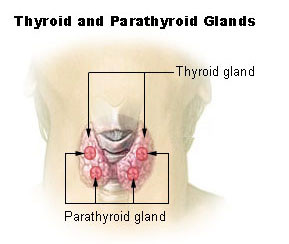Paraythroid Gland Location, Anatomy, Blood and Nerve Supply
What is the parathyroid gland?
The parathyroid glands are four small glands located on the thyroid gland which synthesize and secrete the parathyroid hormone (PTH). It is an endocrine gland that regulates the calcium and phosphorus levels in the blood and bone. Most people have four separate parathyroid glands although rarely, a person may have just two glands and be able to maintain normal parathyroid functioning. Even surgical removal of two parathyroid glands will not affect normal parathyroid functioning, however, the removal of three or more glands with the retention of just one gland can impact on calcium and phosphorus levels in the body. Despite its close proximity to thyroid gland, the parathyroid glands have a distinctly different structure and should not be confused with thyroid activity.
Anatomy of the Parathyroid Glands
There are two parathyroid glands on each side – left and right – with one higher than the other. These glands lie on the left and right lobes of the thyroid gland. The superior parathyroid glands are the uppermost two glands on either side, while the inferior parathyroid glands are the lower two glands on either side.
Each parathyroid gland is is about 6 millimeters long, 3 millimeters wide, and 2 millimeters thick. It weighs between 30 to 40 grams in humans and appears similar to a flattened ball of brown fat. The parathyroid gland comprises mainly of chief cells with a smaller number of oxyphil cells that are absent in the glands of children. While the chief cells are responsible for secretion of most, if not all, of the parathyroid hormone (PTH), the exact function of the oxyphil cells are unknown. It is believed that the oxyphil cells may be depleted chief cells.
Location of the Parathyroid Glands
The parathyroid glands are four small, flattened, oval-shaped nodules that lie on the back of the thyroid gland (posterior surface). More specifically, it lies on the upper half of rear thyroid gland surface, outside the thyroid gland capsule, but contained within the thyroid gland sheath.
The location of the parathyroid glands can vary but the superior parathyroid glands usually stays the same in most people. It is located about 1 centimeter about the entry point of the inferior thyroid arteries around the level of the inferior border of the cricoid cartilage. The position of the inferior parathyroid glands can vary significantly, usually located near the inferior poles of the thyroid gland but may extend to the superior mediastinum as well.
Blood Supply and Lymphatic Supply to the Parathyroid Glands
Arterial blood is derived via branches of the superior and/or inferior thyroid arteries. It may also arise via branches from other arteries in thr area including the laryngeal, tracheal and/or esophageal arteries.Venous drainage is via the parathyroid veins which empty into the thyroid venous plexus. Lymphatic drainage is similar to the thyroid gland with vessels emptying into the deep cervical lymph nodes and paratracheal lymph nodes.
Nerve Supply of the Parathyroid Glands
The nerve supply to the thyroid gland is via the cervical sympathetic ganglia. It controls the blood supply to the gland (vasomotor) rather than hormone secretion. Parathyroid hormone secretion is regulated by the calcium levels in the blood – low calcium levels stimulates parathyroid hormone secretion.



